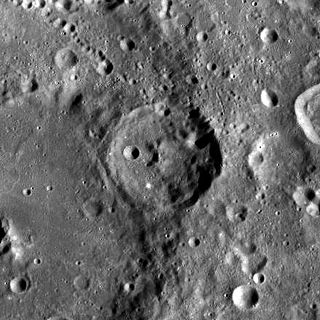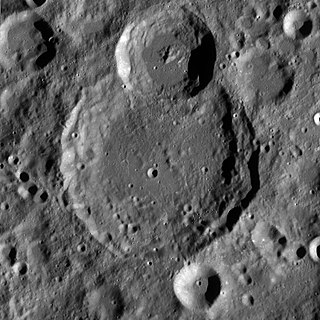 LRO image | |
| Coordinates | 27°18′N144°12′W / 27.3°N 144.2°W Coordinates: 27°18′N144°12′W / 27.3°N 144.2°W |
|---|---|
| Diameter | 96 km |
| Depth | Unknown |
| Colongitude | 145° at sunrise |
| Eponym | James Prescott Joule |

Joule is a lunar impact crater that lies on the far side of the Moon. It is located to the north-northeast of the walled plain Mach. To the northwest of Joule is the crater Blazhko.

Lunar craters are impact craters on Earth's Moon. The Moon's surface has many craters, almost all of which were formed by impacts.

An impact crater is an approximately circular depression in the surface of a planet, moon, or other solid body in the Solar System or elsewhere, formed by the hypervelocity impact of a smaller body. In contrast to volcanic craters, which result from explosion or internal collapse, impact craters typically have raised rims and floors that are lower in elevation than the surrounding terrain. Impact craters range from small, simple, bowl-shaped depressions to large, complex, multi-ringed impact basins. Meteor Crater is a well-known example of a small impact crater on Earth.

Earth's Moon is an astronomical body that orbits the planet and acts as its only permanent natural satellite. It is the fifth-largest satellite in the Solar System, and the largest among planetary satellites relative to the size of the planet that it orbits. The Moon is, after Jupiter's satellite Io, the second-densest satellite in the Solar System among those whose densities are known.
This is a worn and eroded crater formation. A pair of smaller craters lies along the northeastern rim, and a crater is intruding into the northwest rim. To the south is an outward projection that has the appearance of a crater partly overlain by Joule. The remainder of the rim and inner wall is somewhat irregular. The interior floor is more level than the terrain surrounding the crater, but is marked by some small craterlets. At the midpoint of the interior floor is a central peak.
Joule T is located less than a crater diameter to the west of Joule. A smaller crater named Wargo with a prominent ray system lies on the western edge of Joule T. These rays primarily project to the south of the crater, with the most prominent ray crossing the crater Harvey to the south. Only faint traces of this ray system actually cross into Joule, and are generally restricted to the western rim, inner sides and floor.

Wargo is a lunar crater on the far side of the Moon. It is located to the south of Blazhko, and to the west of Joule.

A ray system comprises radial streaks of fine ejecta thrown out during the formation of an impact crater, looking somewhat like many thin spokes coming from the hub of a wheel. The rays may extend for lengths up to several times the diameter of their originating crater, and are often accompanied by small secondary craters formed by larger chunks of ejecta. Ray systems have been identified on the Moon, Earth, Mercury, and some moons of the outer planets. Originally it was thought that they existed only on planets or moons lacking an atmosphere, but more recently they have been identified on Mars in infrared images taken from orbit by 2001 Mars Odyssey's thermal imager.

Harvey is a lunar impact crater that is located on the far side of the Moon from the Earth. It lies astride the eastern rim of the much larger crater Mach, and the outer rampart of Harvey extends part way across the interior floor. Some distance to the north of Harvey is the crater Joule, and equally far to the east-southeast is Kekulé.




















